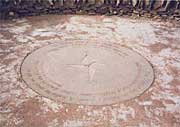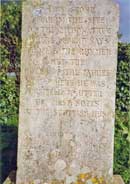Thomas the Rhymer
The ballad is usually told in Scots but an English version starts as follows:-
 True Thomas sat on Huntley bank,
True Thomas sat on Huntley bank,
And he beheld a lady gay;
A lady that was brisk and bold,
Come riding o’er the ferny brae.
Her skirt was of the grass green silk,
Her mantle of the velvet fine;
At every lock of her horse’s mane,
Hung fifty silver bells and nine.
Thomas of Ercildoune - more commonly known as Thomas the Rhymer - was a soothsayer of such repute that for a time his fame rivalled that of the 6 th century magician Merlin.
There are many variations of the story all with common threads. Very few folk tales are given such belief as that of Thomas and the Queen of the fairies. Thomas was a real person and his predictions – which were written down - were treated so seriously that they were consulted before both the two Jacobite rebellions.
 He was born around 1220, and lived in Learmont Tower, near Ercildoune, now Earlston in Berwickshire. Close by there stood a grove of hardwood trees on the banks of Huntly Burn and as a youngster Thomas had a favourite tree under which he used to lie.
He was born around 1220, and lived in Learmont Tower, near Ercildoune, now Earlston in Berwickshire. Close by there stood a grove of hardwood trees on the banks of Huntly Burn and as a youngster Thomas had a favourite tree under which he used to lie.
The story goes that as he lay there one day he saw the beautiful Queen of the Fairies approaching on her graceful white horse. She was wearing green silk and velvet and on her horse's mane there hung 59 silver bells. Thomas was entranced by her beauty and readily complied when the Queen asked him to kiss her underneath his favourite tree. He then agreed to accompany her, and the two rode off into the Eildon Hills where Thomas spent seven years as the Queen's lover in her fairy home in Elfland.
The years seemed only a few minutes to Thomas. But when the time came for the Queen to return him to mortal land, she made him promise never to speak of what he had seen. He agreed and she gave him an apple and said: "Take this for thy wages Thomas, it will give thee a tongue that can never lie."
From then on he was known as "True Thomas". The Queen also conferred on him the gift of prophecy. He used his new powers to prophesy several significant historical events including the death of King Alexander III, the succession of Robert the Bruce to the throne of Scotland, the defeat of the Scots at the Battle of Flodden, the defeat of Mary, Queen of Scots' forces at the Battle of Pinkie in 1567. He is also said to have predicted the Scottish success at the Battle of Bannockburn and the Jacobite uprisings of 1715 and 1745.
Merlin’s grave is claimed to be near where the Drumelzier (Powsail) Burn joins the Tweed. Thomas foretold that the burial site would flood when Scotland and England had a single monarch:
When the Tweed and Powsail meet at Merlin's grave,
Scotland and England that day ae king shall have.
That burial ground did flood. The date was 25th July 1603, the day on which James VI of Scotland was crowned James I of England. (It is said that the burn had not before, and has not since, flooded at this point).
The story of Thomas is told in the ballad Thomas the Rhymer, which was collected by Sir Walter Scott in his work, Minstrelsy of the Scottish Border, also recordings of the ballad have been made by various artists such as the folk-rock band Steeleye Span and Scottish folk musician Ewan MacColl.
There is one final twist to the saga of Thomas the Rhymer. One day, many years after returning from Elfland, he walked out of his house to his favourite tree under which he had first met the Queen. He has never returned and has not been seen since.
According to legend he will return one day to help Scotland in her hour of greatest need. Some might say that time is not far off.
The plaque and gravestone that supposedly mark the spot where Thomas sat, is a mile or so east of Melrose overlooking the Tweed.
